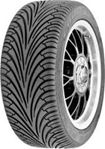The different types: symetrical, asymetrical et directional
Not all tyres share the same design. The tread pattern of a tyre determine its performance
There are three main types of tread patterns :
- Symetrical
- Asymetrical
- Directional
Please find below a few explanations to help you select the tye best adapted to your driving style :
Symetrical

Usage
Designed for short commutes for small passenger cars.
Strenghts
- High resistance
- Improved tread life
- Économical
- Excellent road handling
- Comfortable driving
Weaknesses
- Average steering responsiveness
- Weak resistance to aquaplaning
Special features
- There is no compulsory mounting order for this tyre.
- Available in small sizes (from 13" to 15")
Asymetrical

Usage
Designed for powerful sedans and sportscars
Strenghts
- Quiet driving
- High resistance to aquaplaning
- High stability
Weaknesses
- Flexible sidewalls ( less resistance to shocks)
- More expensive
- Shorter longevity
Special features
- « outside » and « inside » markings are engraved on the sidewall, they indicate the correct mounting order.
- Available in sizes 15" to 19".
Directional

Usage
Designed for sportscars
Strenghts
- Outstanding steering responsivess
- Good road handling on wet and snow
- High resistance to aquaplaning risks
- Good grip on wet
- Predictable handling at high speeds
Weaknesses
- Not economical
- Weaker resistance to shocks ( flexible sidewalls)
- Worns out faster
Special features
- Mounting : Directional, small white arrows indicate on what axle each tyre has to be placed
- Front to rear ( and rear to front) tyre rotation only


